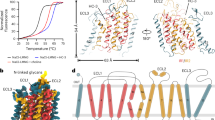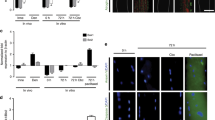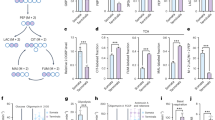Abstract
THE ultimate step of acetylcholine (ACh) synthesis in cholinergic nerve terminals is the transfer of an acetyl group from one molecule of acetyl coenzyme A (acetyl CoA) to one molecule of choline. This reaction is catalysed by choline acetyltransferase (CAT; EC 2.3.1.6), a cytoplasmic enzyme1. As revealed by isotopic studies, glucose as well as pyruvate can be used as precursor of the acetyl moiety of ACh in mammalian brain tissue2–5. From the equal efficiency of (1-14C) and (6-14C)glucose in labelling ACh, it was concluded that glucose is transformed into pyruvate through the Embden–Meyerhof pathway. As (2-14C) and (3-14C)pyruvate but not (1-14C)pyruvate give rise to (14C)ACh, pyruvate must be decarboxylated by a pyruvate dehydrogenase complex (PDHc; EC 1.2.4.1) to generate acetyl CoA, one of the two substrates of CAT. It is usually assumed that PDHc is exclusively located in mitochondria, and so several attempts have been made to understand how the cytoplasmic CAT is supplied in acetyl CoA. In spite of the great diversity of approaches used, none of the various mechanisms contributing normally to the transfer of acetyl groups through the inner mitochondrial membrane6 seem to be involved in the synthesis of ACh in brain cholinergic nerve endings3–5,7–10. An alternative hypothesis was thus proposed which assumed the existence of two populations of PDHc within cholinergic nerve endings. Apart from the ubiquitous intramitochondrial PDHc providing the Krebs cycle with activated acetyl groups, an extramitochondrially located PDHc could exist which would be specifically involved in providing acetyl CoA to the cytoplasmic enzyme, CAT. Acetyl CoA used for the neurotransmitter synthesis would thus be generated in the same subcellular compartment in which ACh is formed11. Experiments are described here which confirm the validity of this hypothesis.
This is a preview of subscription content, access via your institution
Access options
Subscribe to this journal
Receive 51 print issues and online access
$199.00 per year
only $3.90 per issue
Buy this article
- Purchase on Springer Link
- Instant access to full article PDF
Prices may be subject to local taxes which are calculated during checkout
Similar content being viewed by others
References
Fonnum, F. Biochem J. 103, 262–270 (1967).
Cheney, D. L., Gubler, C. L. & Jaussi, A. W. J. Neurochem. 16, 1283–1291 (1969).
Tuček, S. & Cheng, S. C. Biochim. biophys. Acta 208, 538–540 (1970).
Sollenberg, J. & Sorbo, B. J. Neurochem. 17, 201–207 (1970).
Nakamura, R., Cheng, S. C. & Naruse, M. Biochem. J. 118, 443–450 (1970).
Greville, G. D. in Citric Acid Cycle: Control and Comparimentation (ed. Lowenstein, J. M.) 68–69 (Marcel Dekker, New York, 1969).
D'Adamo, A. F. & D'Adamo, A. P. J. Neurochem. 15, 315–323 (1968).
Tuček, S. J. Neurochem. 14, 519–529, 531–545 (1967).
Tuček, S. & Cheng, S. C. J. Neurochem. 22, 893–914 (1974).
Lefresne, P. thesis, Univ. Paris VI (1974).
Lefresne, P., Hamon, M., Beaujouan, J. C. & Glowinski, J. Biochimie 59, 197–215 (1977).
Iversen, L. L. & Schon, F. E. in New Concepts in Neurotransmitter Regulation (ed. Mandell, A. S.) 153–193 (Plenum, New York, 1973).
Gray, E. G. & Whittaker, V. P. J. Anat. 96, 79–88 (1962).
Lefresne, P., Guyenet, P. & Glowinski, J. J. Neurochem. 20, 1083–1097 (1973).
Guyenet, P., Lefresne, P., Rossier, J., Beaujouan, J. C. & Glowinski, J. Molec. Pharmac. 9, 630–639 (1973).
Snedecor, G. W. & Cochran, W. G. in Statistical Methods (Iowa State University Press, 1967).
Author information
Authors and Affiliations
Rights and permissions
About this article
Cite this article
LEFRESNE, P., BEAUJOUAN, J. & GLOWINSKI, J. Evidence for extramitochondrial pyruvate dehydrogenase involved in acetylcholine synthesis in nerve endings. Nature 274, 497–500 (1978). https://doi.org/10.1038/274497a0
Received:
Accepted:
Issue Date:
DOI: https://doi.org/10.1038/274497a0
This article is cited by
-
Metabolic fuel utilization and pyruvate oxidation during the postnatal period
Journal of Inherited Metabolic Disease (1996)
-
Choline acetyltransferase-like activity bound to neuronal plasma membranes
Neurochemical Research (1988)
-
Effect of external high potassium and pH on the uptake of choline in glial and neuronal cells in culture
Neurochemical Research (1987)
-
Regulation of acetylcholine synthesis in presynaptic endings of cholinergic CNS neurons
Neurophysiology (1984)
Comments
By submitting a comment you agree to abide by our Terms and Community Guidelines. If you find something abusive or that does not comply with our terms or guidelines please flag it as inappropriate.



